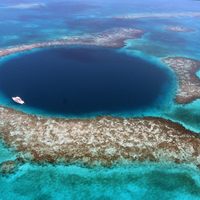The Mysterious Blue Holes of Malta: Underwater Wonders Revealed
Imagine a world beneath the surface of the Mediterranean, where crystal-clear waters conceal secrets that have intrigued explorers and scientists alike for centuries. In the heart of this maritime mystery lies Malta, a small archipelago with a big secret— the enigmatic blue holes that dot its coastline.
Discovering the Depths: Malta’s Unique Underwater Landscape
Malta, known for its rich history and stunning landscapes, hides a unique underwater treasure trove. The blue holes are natural sinkholes formed by the collapse of cave systems, creating deep, captivating cavities in the sea floor. What makes them even more fascinating is the vibrant blue hue of the water, a result of the interplay between sunlight and the depth of the holes.
These underwater wonders are scattered around the islands, with some of the most famous ones located off the coast of Gozo, the second-largest island in the archipelago. Dwejra Bay, in particular, is a hotspot for divers eager to explore the mesmerizing beauty hidden beneath the waves.
Diving Into the Blue: A Subaquatic Adventure
For thrill-seekers and diving enthusiasts, the blue holes of Malta offer an unparalleled experience. The crystal-clear waters provide visibility that can extend up to 30 meters, allowing divers to witness the intricate underwater topography and the diverse marine life that calls these holes home.
The most renowned blue hole, aptly named the “Azure Window,” was once an iconic limestone arch that stood proudly above the water. Unfortunately, this natural wonder collapsed in 2017, leaving behind a submerged arch and an even more intriguing diving site. The underwater arch, covered in colorful corals and inhabited by schools of fish, has become a symbol of nature’s resilience.
The Flora and Fauna: Breathtaking Biodiversity
Beneath the surface of the blue holes, a thriving ecosystem awaits discovery. The intricate cave systems provide shelter for an array of marine life, from tiny crustaceans to larger species such as groupers and barracudas. Divers often encounter vibrant coral formations, creating a kaleidoscopic backdrop to their underwater adventures.
The unique geology of the blue holes contributes to the abundance of marine biodiversity. The constant influx of nutrient-rich water from the open sea sustains a delicate balance, making these underwater formations not only visually stunning but also vital hubs for marine conservation.
Preserving the Underwater Heritage: Responsible Tourism
As the allure of Malta’s blue holes grows, it becomes crucial to balance tourism with conservation efforts. Divers and snorkelers alike must adhere to responsible practices, respecting the delicate ecosystems that flourish in these underwater havens. Local initiatives, such as clean-up campaigns and educational programs, aim to raise awareness about the importance of preserving Malta’s underwater heritage for future generations.
The Maltese government has also implemented measures to regulate diving activities, ensuring that these natural wonders remain untouched by irresponsible practices. By promoting sustainable tourism, Malta strives to maintain the pristine beauty of its blue holes while allowing visitors to experience the magic of the underwater world.
FAQs: Unraveling the Mysteries of Malta’s Blue Holes
Q1: Are the blue holes accessible to non-divers?
Absolutely! While diving provides the most immersive experience, non-divers can still appreciate the beauty of the blue holes. Snorkeling tours are available, allowing you to marvel at the vibrant marine life and crystal-clear waters from the surface.
Q2: Are the blue holes suitable for beginners in diving?
Yes, some of the blue holes are suitable for novice divers. However, it’s essential to choose dive sites with shallower depths and calm conditions. Local dive centers offer training and guided dives for divers of all experience levels.
Q3: What is the best time to visit Malta for diving?
The best time for diving in Malta is during the summer months, from May to October, when the water is warm and visibility is at its peak. However, the islands offer diving opportunities throughout the year, with unique experiences in each season.
Embark on a journey into the unknown, where the azure waters of Malta’s blue holes unveil a world of wonder and mystery. Whether you’re an avid diver or a curious traveler, these underwater wonders promise an adventure like no other. Dive deep, explore, and let the secrets of the blue holes captivate your senses.

